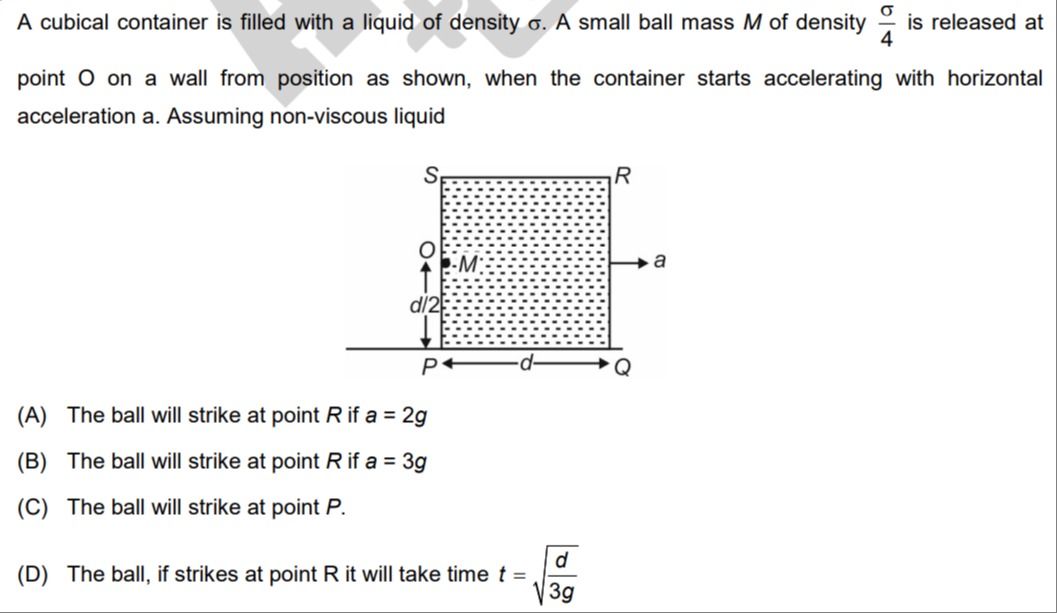Question
Question: A cubical container is filled with a liquid of density $\sigma$. A small ball mass $M$ of density $\...
A cubical container is filled with a liquid of density σ. A small ball mass M of density 4σ is released at point O on a wall from position as shown, when the container starts accelerating with horizontal acceleration a. Assuming non-viscous liquid

The ball will strike at point R if a = 2g
The ball will strike at point R if a = 3g
The ball will strike at point P.
The ball, if strikes at point R it will take time t=3gd
The ball will strike at point R if a = 2g
Solution
The problem describes the motion of a ball in an accelerating liquid-filled container. We analyze the motion in the non-inertial frame of the container, which is accelerating horizontally with acceleration a.
In the non-inertial frame, a pseudo force Fpseudo=Ma acts on the ball in the direction opposite to the container's acceleration.
The gravitational force on the ball is Fg=Mg downwards.
The buoyant force in an accelerating fluid is given by FB=−ρliquidV(g−acontainer), where V is the volume of the ball, ρliquid is the density of the liquid, g is the acceleration due to gravity, and acontainer is the acceleration of the container.
The volume of the ball is V=ρballM=σ/4M=σ4M.
Let the x-axis be horizontal to the right and the y-axis be vertical upwards. Then g=−gj^ and acontainer=ai^.
The buoyant force is FB=−σ(σ4M)(−gj^−ai^)=4M(gj^+ai^).
The pseudo force is Fpseudo=−Macontainer=−Mai^.
The gravitational force is Fg=Mgg^=−Mgj^.
The net force on the ball in the non-inertial frame is Fnet=Fg+Fpseudo+FB=−Mgj^−Mai^+4M(gj^+ai^)=−Mgj^−Mai^+4Mgj^+4Mai^=3Mai^+3Mgj^.
The acceleration of the ball relative to the container is aball/container=MFnet=M3Mai^+3Mgj^=3ai^+3gj^.
So, the horizontal acceleration relative to the container is ax=3a and the vertical acceleration relative to the container is ay=3g.
The ball is released from point O, which is on the left wall at a height d/2 from the bottom. The initial velocity of the ball relative to the container is zero.
Let the origin be at point P (bottom left corner). The initial position of the ball is (0,d/2).
The horizontal distance to the right wall is d. The vertical position of the top wall is d.
The horizontal motion is x(t)=x0+v0xt+21axt2=0+0⋅t+21(3a)t2=23at2.
The vertical motion is y(t)=y0+v0yt+21ayt2=2d+0⋅t+21(3g)t2=2d+23gt2.
For the ball to strike the right wall, x(t)=d. Let the time taken be tR.
d=23atR2⟹tR2=3a2d⟹tR=3a2d.
The vertical position when it strikes the right wall is y(tR)=2d+23gtR2=2d+23g(3a2d)=2d+agd.
Point R is the top right corner with coordinates (d,d). For the ball to strike at R, we must have y(tR)=d when x(tR)=d.
d=2d+agd 2d=agd 21=ag⟹a=2g.
So, the ball will strike at point R if a=2g. This confirms option (A).
Let's check the time taken when a=2g.
tR=3a2d=3(2g)2d=6g2d=3gd.
So, if the ball strikes at point R (which happens when a=2g), the time taken is t=3gd. This confirms option (D).
